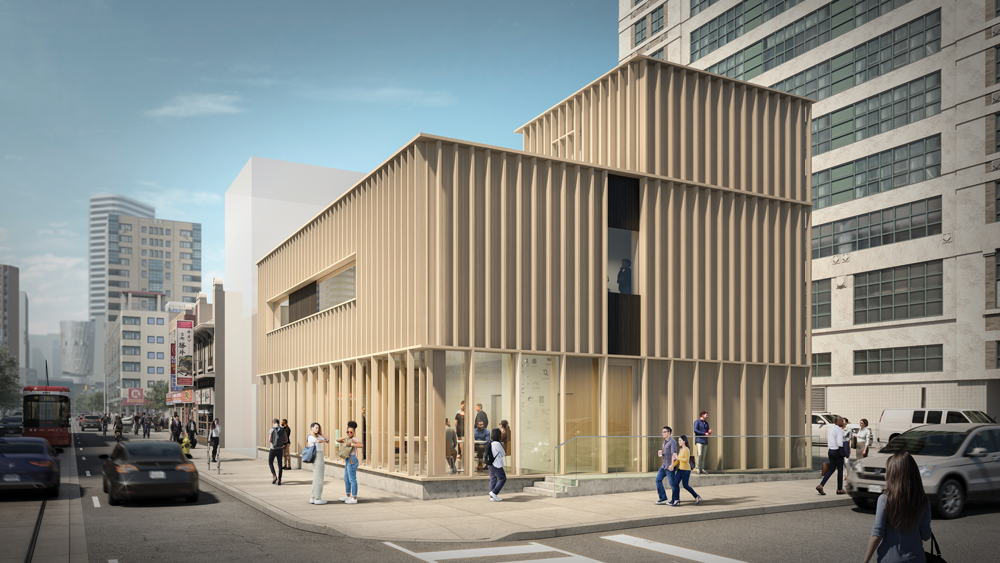
Specifying for smart buildings
April 15, 2022
By Peter Saunders

RENDERING COURTESY WZMH ARCHITECTS.
If you got the chance to design the ideal ‘smart building’ from the ground up, which technologies would you specify?
Last year, Ryerson University announced plans for the Smart Campus Integration and Testing Hub (SCITHub), which it says will be the world’s first 100% digitally enabled building. Set for construction on a vacant lot at 136 Dundas Street East in downtown Toronto, the two-storey, 3,000-sf mass-timber facility will both test and showcase a variety of smart building technologies, before potentially being dismantled again.
Notably, SCITHub is the first project that will integrate the Intelligent Structural Panel (ISP), developed in recent years by WZMH Architects principal Zenon Radewych with support from Stephenson Engineering, Quasar Consulting Group and C3PoE (see Canadian Consulting Engineer, December 2018, cover story). The ISP is a modification of Intelligent Engineering’s sandwich plate system (SPS), which bonds two steel plates with a polyurethane (PU) elastomer to provide a solid-panel alternative to reinforced concrete in walls and floors.
Specifically, the modification adds fibre, copper, a low-voltage DC system and Power over Ethernet (PoE) connectivity, allowing the panels to form a plug-and-play ‘intelligent highway,’ supporting smart building systems to address heating, ventilation and air conditioning (HVAC), lighting, security, power management and more. Circuitry running between the plates resembles the layout of a microchip and the devices are added via RJ45 connectors.
“One of the most important things we realized is the importance of working with consulting engineers in ‘re-mapping’ existing building technology,” says Radewych. “It is time to work more collaboratively and challenge each other with respect to how systems are designed and interact with each other. The goal should be combining systems with a focus on energy efficiency, safety and accessibility.”
WZMH’s innovation lab collaborated with Toronto-based Argentum to develop the various low-voltage devices to interact with the ISP, which won an Award of Excellence in the 2019 Canadian Consulting Engineering Awards.
“Ryerson came to our office to see the mockup of the ISP,” Radewych explains. “It was determined the panel would be a perfect fit for the research building. We are also working with Argentum to see how their DC low-voltage devices can be integrated into SCITHub, including a smart PoE controller that can intelligently control non-PoE devices, such as lights.”
Headed by WZMH associate principal Jamie Lee, SCITHub will incorporate ISPs into its floor slab to provide direct access for its PoE device network. An in-house digital twin will gather the building’s performance data for purposes of further optimization. Cisco, Schneider Electric and Mitsubishi are among the other companies contributing to the project.
“The integration of these systems and various Internet of Things (IoT) components must be addressed at the very early stages of the design process and not treated as an ‘add-on’ feature after all other building components have been specified,” says Radewych. “The key for consulting engineers is to ensure the infrastructure is vendor-neutral for the components that interact within the digital building.”
A connected environment
In the meantime, more modular approaches have continued to be introduced to the market. The O3 Sensor Hub from Delta Controls in Surrey, B.C., is a ceiling-mounted unit that can control a room’s temperature, humidity and lighting as an independent IoT device, without the need for a building management system (BMS).
Indeed, after many years of experience with BMSs, Delta now also offers software-as-a-service (Saas) with its EnteliCloud platform, which centralizes building management operations, site engineering and energy analytics. Executives, energy managers and building operator can view data on personalized dashboards.
“Home automation has become a big business,” says Robert Hemmerdinger, Delta’s chief sales and marketing officer, “and people now expect that immersive, digital, mobile connection to their environment everywhere, including commercial buildings.”
Another factor he cites is COVID-19, which has pushed ‘contactless’ technologies to the fore.
“You can do more from your smartphone now, from turning on a fan to opening doors,” he says.
The company’s Red5 platform has added cybersecurity encryption to building control. It integrates with the O3 Sensor Hub and modules to control HVAC, access, lighting and more.
Assessing the results
Another question is how to measure the performance of a smart building. With this in mind, Underwriters Laboratories (UL) and the Telecommunications Industry Association (TIA) recently developed SPIRE, which they call the world’s first objective, comprehensive self-assessment and rating tool for smart buildings. Based on the collaborative efforts of a working group that includes consulting engineering firms Arup and Stantec, the framework addresses such criteria as connectivity, cybersecurity, power, energy, health, well-being, sustainability and safety.
“SPIRE pushes us to consider real data,” said Dan Michaud, former technology consultant for Arup (and now business technology department leader for HGA Architects and Engineers), in a recent TIA webinar about the rating system. “It focuses on the outcomes of design, system selection, budgets and day-to-day operations. It’s a good way to get ahead of the cybersecurity risks, for example, that face systems in typical buildings today.”
A completed evaluation may earn a verified assessment and rating. There are also plans for benchmarking based on anonymized building performance data.